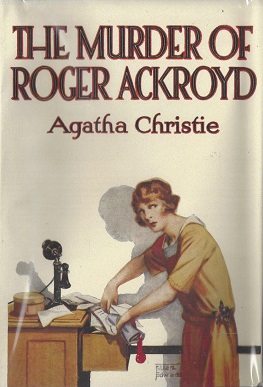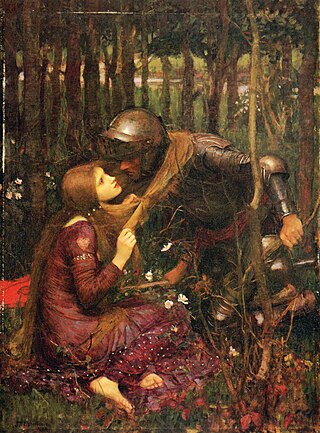This is a bibliography of works by Rudyard Kipling, including books, short stories, poems, and collections of his works.

The Murder of Roger Ackroyd is a detective novel by the British writer Agatha Christie, her third to feature Hercule Poirot as the lead detective. The novel was published in the UK in June 1926 by William Collins, Sons, having previously been serialised as Who Killed Ackroyd? between July and September 1925 in the London Evening News. An American edition by Dodd, Mead and Company followed in 1926.

"La Belle Dame sans Merci" is a ballad produced by the English poet John Keats in 1819. The title was derived from the title of a 15th-century poem by Alain Chartier called La Belle Dame sans Mercy.
Narrative poetry is a form of poetry that tells a story, often using the voices of both a narrator and characters; the entire story is usually written in metered verse. Narrative poems do not need to rhyme. The poems that make up this genre may be short or long, and the story it relates to may be complex. It is normally dramatic, with various characters. Narrative poems include all epic poetry, and the various types of "lay", most ballads, and some idylls, as well as many poems not falling into a distinct type.

The Secret of Chimneys is a work of detective fiction by British writer Agatha Christie, first published in the UK by The Bodley Head in June 1925 and in the US by Dodd, Mead and Company later in the same year. It introduces the characters of Superintendent Battle and Lady Eileen "Bundle" Brent. The UK edition retailed at seven shillings and sixpence (7/6) and the US edition at $2.00.

Jean Ingelow was an English poet and novelist, who gained sudden fame in 1863. She also wrote several stories for children.

Death on the Nile is a work of detective fiction by British writer Agatha Christie, published in the UK by the Collins Crime Club on 1 November 1937 and in the US by Dodd, Mead and Company the following year. The UK edition retailed at seven shillings and sixpence (7/6) and the US edition at $2.00.) The book features the Belgian detective Hercule Poirot. The action takes place in Egypt, mostly on the River Nile. The novel is unrelated to Christie's earlier (1933) short story of the same name, which featured Parker Pyne as the detective.

Lady Margaret Sackville was an English poet and children's author.
— Opening lines from The Waste Land by T. S. Eliot, first published this year
Nationality words link to articles with information on the nation's poetry or literature.
Nationality words link to articles with information on the nation's poetry or literature.
The Percy Society was a British text publication society. It was founded in 1840 and collapsed in 1852.
Leah Bodine Drake was an American poet, editor, and critic.

Dreams from R'lyeh is a collection of poems by Lin Carter. The book was released in hardcover by Arkham House in 1975 in an edition of 3,152 copies. It was Carter's only book published by Arkham House. The title sequence of sonnets, "Dreams from R'lyeh", has also been reprinted in Robert M. Price's The Xothic Legend Cycle: The Complete Mythos Fiction of Lin Carter.

Poems is the second of two collections of poetry by crime writer Agatha Christie, the first being The Road of Dreams in January 1925. It was published in October 1973 at the same time as the novel Postern of Fate, the final work she ever wrote.
Charles Thomas Osborne was an Australian journalist, theatre and opera critic, poet and novelist. He was the assistant editor of The London Magazine from 1958 until 1966, literature director of the Arts Council of Great Britain from 1971 until 1986, and chief theatre critic of Daily Telegraph (London) from 1986 to 1991.

Edith Matilda Thomas was an American poet who "was one of the first poets to capture successfully the excitement of the modern city."
Jill Hellyer (1925–2012) was an Australian poet and writer, and one of the founding members of the Australian Society of Authors. She was awarded an Order of Australia Medal (OAM) for services to Australian poetry.

Marjorie Lowry Christie Pickthall, was a Canadian writer who was born in England but lived in Canada from the time she was seven. She was once "thought to be the best Canadian poet of her generation."
Cultural references to Pierrot have been made since the inception of the character in the 17th century. His character in contemporary popular culture — in poetry, fiction, and the visual arts, as well as works for the stage, screen, and concert hall — is that of the sad clown, often pining for love of Columbine, who usually breaks his heart and leaves him for Harlequin. Many cultural movements found him amenable to their respective causes: Decadents turned him into a disillusioned foe of idealism; Symbolists saw him as a lonely fellow-sufferer; Modernists converted him into a Whistlerian subject for canvases devoted to form and color and line.










